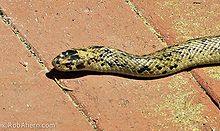- Dugite
-
Dugite 
Dugite in Western Australia,
Pseudonaja affinisScientific classification Kingdom: Animalia Phylum: Chordata Class: Reptilia Order: Squamata Suborder: Serpentes Family: Elapidae Genus: Pseudonaja Species: P. affinis Binomial name Pseudonaja affinis
(Günther 1872)subspecies Dugite (pronounced /ˈdjuːɡaɪt/) is a common name for the highly venomous snake, Pseudonaja affinis, an Australian species which can inflict a fatal bite.
Contents
Description
Dugites are coloured grey, green or brown. The colours vary widely between individuals and are an unreliable means of identifying species. The most distinguishing characteristic is the shape of the head, this is small compared to the neck, and grades imperceptibly into the body. They can grow up to 2m long.
Distribution and habitat
 A dugite taken in Joondalup, Western Australia.
A dugite taken in Joondalup, Western Australia.
Members of the genus are found in southern parts of Western Australia and in remote coastal parts of western South Australia. They prefer sandy areas and like most snakes will not normally approach populated areas but may be seen if looking for food and water. In Western Australia they are currently common in bushland areas, but their numbers are diminishing.
Conservation status
Dugites are protected under the Wildlife Conservation Act 1950 and to kill or injure one attracts a fine of up to A$4000.[1]
Behavior
Like other brown snakes, dugites are diurnal. The female dugite lays 10 to 20 eggs at a time.
Its venom is potentially one of the most lethal in the world, causing coagulopathic and procoagulant effects.[2] Dugites generally avoid biting humans, but risks of encounters rise when they are most active during the mating season through October and November.[3]
The last death attributed to a dugite was in 1993 after an elderly man died in Spearwood, Perth.[3]
In January 2011, a seven year old Perth boy was bitten and temporarily paralyzed after a Dugite crawled into his bedroom and wrapped itself around his arm while he slept. After seeking medical attention quickly, he made a full recovery.
Name and classification
The species was first described by Albert Günther in 1872.[4] It is a member of the genus Pseudonaja, sometimes referred to as Brown snakes, contained by the Elapidae family.[5] The descriptions of three subspecies are currently accepted, they are:[6]
- Pseudonaja affinis affinis
- Pseudonaja affinis exilis Storr 1989[7]
- Pseudonaja affinis tanneri (Worrell) 1961[8]
See also
- The Dugites - 1970s Perth band
Notes
- ^ Dramatic increase in snake attacks on pets Narelle Towie, PerthNow, 2007-11-26. Retrieved 2008-03-13
- ^ Identification of PLA2 and alpha-Neurotoxin Proteins in the Venom of Pseudonaja affinis (Dugite) Judge R.K., Henry P.J., d'Aprile A.C., Lynch D., Jelinek G., Wilce M.C.J., Wilce J.A. Source: Toxicology and Applied Pharmacology, Volume 181, Number 3, June 2002 , pp. 184-191(8) Publisher: Academic Press
- ^ a b Dugites love to live near people ABC, 10 August 2004. Cached by Google
- ^ Günther,A. 1872. Seventh account of new species of snakes in the collection of the British Museum. Ann. Mag. Nat. Hist. (4) 9: 13-37
- ^ "Pseudonaja affinis". Integrated Taxonomic Information System. http://www.itis.gov/servlet/SingleRpt/SingleRpt?search_topic=TSN&search_value=700661.
- ^ Pseudonaja affinis at the Reptarium.cz Reptile Database
- ^ Storr, G. M. 1979. Dangerous Snakes of Western Australia. Perth : Western Australian Museum Press 3rd edn., 24 pp.
- ^ Worrell, E. 1961. A new insular brown snake. Proceedings of the Royal Zoological Society of NSW 1958-59: 56-58 as (Demansia nuchalis tanneri: 56)
Further reading
- Bush, Brian et al. (2007) Reptiles and frogs in the bush : southwestern Australia Crawley, W.A. : University of Western Australia Press. ISBN 9781920694746
- Storr, G. M. (1988) Dangerous snakes of Western Australia Perth, W.A. Western Australian Museum. ISBN 072447975
- Storr, G. M. (2002) Snakes of Western Australia Perth, W.A. Western Australian Museum. ISBN 0730712958
- Swan, Gerry. (1995) A photographic guide to snakes & other reptiles of Australia Frenchs Forest, N.S.W. New Holland Publishers. ISBN 1853685852
External links
Categories:- Elapidae
- Reptiles of Australia
- Reptiles of Western Australia
- Animals described in 1872
Wikimedia Foundation. 2010.
